Shawcraft Models started in 1947 in a private garage in Southall and moved to Iver c1948-9; there were three partners, Reg Haynes, an ex-Army Intelligence officer and artist, W A (Bill) Roberts, a Welshman from Penydarren, Merthyr who moved to Southall before WWII and became an Airscrews and Miles Aircraft engineer and Stan Wilkins an ex-RAF toolmaker who lived near LAP. They had all been post-war model-makers with the famous 1930s firm of Woodason Aircraft Models (WAM) run by Vic Woodason who traded from a corner of the world's first concrete blister hanger on Heston airfield. He later moved the business to his private garage at 604, London Road, Langley, opposite the Ford Motor Company's van works on land that used to be Hawker Aircraft's Langley airfield.
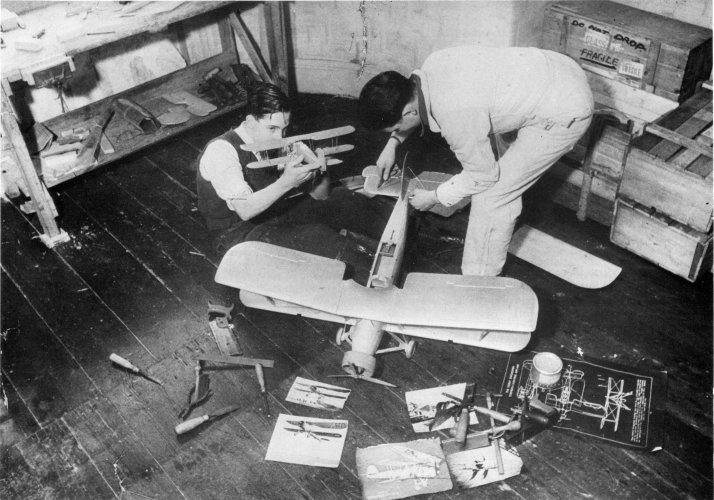
When Shawcraft moved to Iver, they rented the original wooden carpenter's work shop from the estate agent Alfred King next to Iver station; it had been erected by Messrs Limpus & Sons of Kingston-on-Thames to make the doors and windows for the Richings Park Estate that commenced construction in 1922. Shawcraft also rented four lock-up terraced garages from King some 40 yards to the rear of the workshop that were reached via a cinder track next to Hoey's haberdashery on Bathurst Walk.
The 90ft x 25ft workshop was clad in weather boarding under a tarred fibre ridge roof; the first 60ft of the workshop was mounted on 4ft high brick piers to create under floor storage. Shawcraft used it to store redundant moulds and patterns and the bulk of their raw material for model-making, ie lime, mahogany and gelutong timber. The under floor storage area was also home to an expanding family of large grey rats that regularly invaded the workshop looking for food and if one entered at night from the wood mill end, they raced past in the dark bumping in to one's legs as they headed for home. The remaining 30ft of the workshop housed the ground floor wood mill where the bulk timber was machined to suit individual projects by Bill Robert's brother-in-law, Berrie Edwards - an ex-Hurricane pilot with Battle of Britain experience who also lived in Southall. A small concrete toilet block stood next to the wooden staircase giving access to the workshop at the western end towards the shops.
The workshop was parallel to Bathurst Walk and lay behind a plot of waste land that separated the corner shops from Hoey's haberdashery store. The waste land was used by Shawcraft in 1954 to erect their full-size replica of the Vickers Vimy aircraft they built for the British Lion film, The Long Hop. The works were accessed from a cinder track opposite Richings Motors or from the other end of the track next to Hoey's store leading into Bathurst Walk and also gave access to the lock-up garages at the rear. Two of the garages were converted into a modern spray shop under the control of Charlie Carlton, who lived in a flat over Hoey's shop and was another relation of Bill Roberts. Another garage was used to store redundant moulds and two 10ft sailing ships of the Nelson era built for the film Hornblower & the Atropos. The fourth garage was a small workshop used to produce a long running contract of animated Rolls-Royce Dart turbo-prop engines that were made by Ron Giddings.
The interior of the workshop resembled the deck of a galleon for above the wood mill the 'poop deck' housed Stan Wilkins and Ron Waldron who made intricate 1/8th scale sales promotion model cars for the Ford Motor Co. My old school chum John Stears also worked in that area before he left to make his fortune in special effects at Pinewood Studios working for J Arthur Rank on mainly James Bond films for which he was awarded two Oscars.
The main body of the 60ft workshop was divided into two areas, on the left stood two wood and metal working lathes and on the right a series of benches for the rest of the model-makers. The office with its floor level letter slot was at the opposite end of the workshop next to the main entrance and the staircase to the outside. Next to the office were the main fuse box and an antiquated electric cooker on which the workers heated soup, made tea and melted blocks of Vinatex for rubber moulds. The inner wall of the office had a hatchway for ease of communication with the works foreman, Vic Bowden (1926-) an ex-RAF Meteor pilot who joined the company in 1952 and stayed for the next 42 years. The hatchway allowed him to reach through into the office to take telephone calls when the office was unmanned; the phone also provided contact with the spray shop in the lock-up garages some 100ft away.
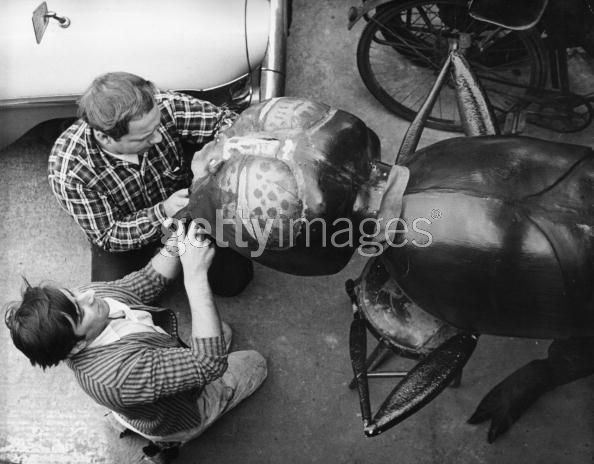
The machinery in the workshop consisted of a Drummond lathe on which wooden bullets were turned out for the film industry; a larger metal-working lathe, a combined jig-saw and disc sander, a profile shaping machine and a pillar drill. Many large sections of the wooden workshop walls, usually about 8-10ft long, could be hinged or removed for the removal of large models onto the flat-bed of collecting lorries.
In 1952/3, Shawcraft produced several components for the Somers Kendal SK1 lightweight jet aircraft designed by Hugh Kendall, the ex-test pilot for Miles Aircraft (where he met Bill Roberts); it was often flown by his business partner in the project, Nat Somers, an ex-1930s Vickers test pilot and winner of many King's Cup Air races. This work resulted in Shawcraft becoming ARB and AID approved to make the fuselage assembly jig, the jig for pre-moulding the front fuselage plywood skin, the jig for making the aluminium engine cowling, moulds for synthetic rubber components for the fuel system, the wooden mould to make the vacuum formed acrylic cockpit canopy, the grp nose and tail cones, the drag-chute housing, wing-tips, the undercarriage doors and the foot-well boxes. They also made the vee tail that operated as both rudder and elevator, the fuselage frames, the control column, and the levers to operate the under-carriage, flap and air-brake. The clear view windscreen panel was adapted from a wartime Horsa glider. The SK1 registration, G-AOBG, did most of its test flying from Woodley, near Reading and White Waltham near Maidenhead where it achieved a top speed of 288km. It weighed 810lb empty and 15,000lb fully laden and was rated as the smallest jet aircraft in the world at that time. To create interest and appeal to a potential market, where it was intended to sell for £10,000, Nat Somers made a bid on the 1km closed circuit air speed record at de Havilland's Hatfield aerodrome in the sixties. Unfortunately, he retracted the undercarriage too early and the plane bellied down the runway but was saved from severe damage by an ash skid fitted by Shawcraft between the nose and undercarriage for this purpose.
The SK1 continued flying for some years until the Blackburn Turbomecca Palas 350lb thrust engine became obsolete; the plane was relegated to an air museum in the North of England.
Reg Haynes employed me in August 1955 as a trainee model-maker following my demob from the RAF and my first job was making the wooden master patterns for 1/72nd scale Hawker Hurricanes and Vickers Supermarine Spitfires that were cast in bronze for the film Reach for the Sky - the story of Douglas Bader.
I progressed to repairing illuminated landscape models for the British Transport Commission and illuminated 1/16th scale cutaway models of Elizabethan, Viscount, Britannia and Trident airliners for travel agents to promote BEA, BOAC, and Aer Lingus.
When Reg Haynes retired to run a craft shop in Keswick in 1956, Bill Roberts bought out his partners to form Shawcraft (Models) Ltd. and became the sole managing director. I became his assistant and went on to become office manager and then general manager by the time the Company acquired a second factory at 69 Rockingham Road Uxbridge in 1959.
Many of the Shawcraft exhibition models were photographed in monochrome by the local Richings Park photographer, Freddie Standewick who lived and worked in a studio flat opposite the bakery in Bathurst Walk. His pictures of the Company's models were often used by such magazines as 'Flight' and 'The Aeroplane'. Other photographs of the larger special effects such as the 40ft Titanic liner and the 32ft Graf Spey battleship were taken and published by Middlesex Advertiser & Gazette. I designed the first Shawcraft brochure for use at The Royal Show in Bristol in the late fifties and it was printed by Ian Young from his small print works within Richings Park Motors.
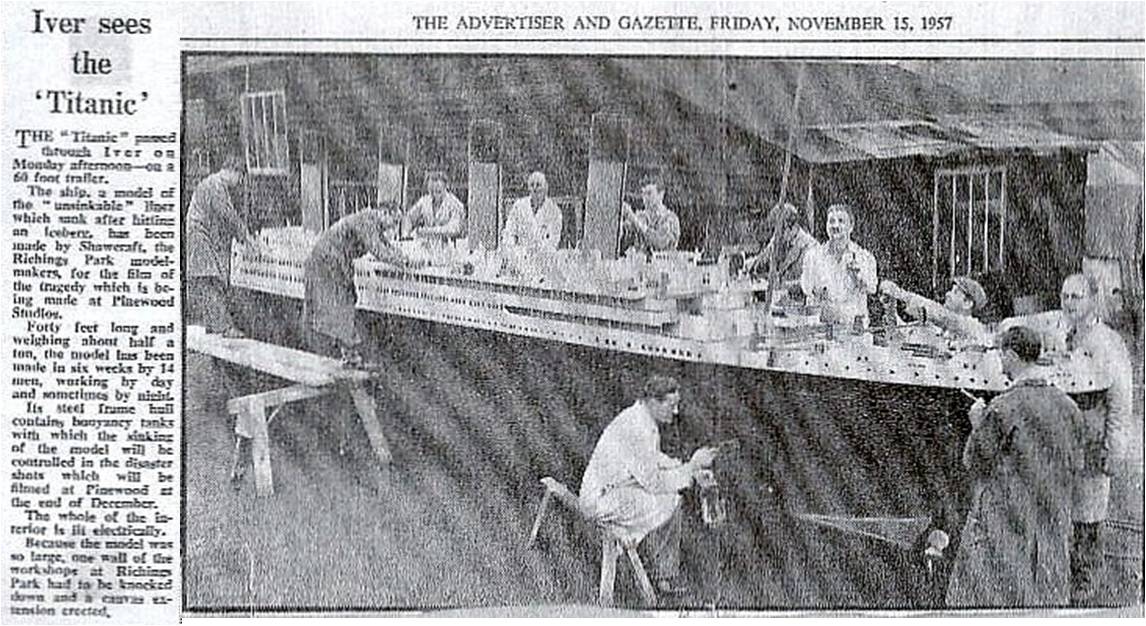
Shawcraft's models and full size replicas for special effects in the film industry appeared in more than 25 films made by such studios as J Arthur Rank, British Lion, Hammer Films, Ealing Studios and Shepperton and ranged from aircraft with 3ins wingspan to a 68ft wingspan replica of the Vickers Vimy and a 40ft model of the Titanic. The films included such epics as, 'Above Us the Waves', 'Angels One Five', 'The Malta Story', 'The Purple Plain', 'The Net', 'Quartermas II', 'Check Point', 'Reach for the Sky', 'The Battle of the River Plate', 'Sea Fury', 'Hornblower & the Atropos', 'Campbell's Kingdom', 'The Sleeping Prince', 'The Curse of Frankenstein', 'The Abominable Snowman', 'Ill Met by Moonlight', 'Yangtse Incident', 'A Night to Remember', 'Sink the Bismark', 'Chitty Chitty Bang Bang', 'The Castaways', 'Superman II', 'The Guns of Naverone', 'The Bedford Incident' and 'Cromwell'.
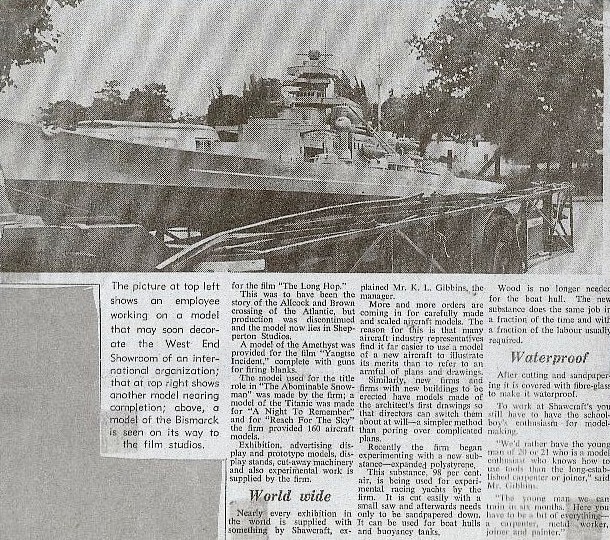
Architectural models also featured among Shawcraft's production including factory layouts for Nuclear Engineering on Langley airfield, Johnson & Johnson the pharmaceutical manufacturers on Slough trading estate and housing development for the Uxbridge town council.
The location of the works on the edge of a prosperous estate led to many approaches from residents that ranged from pleas to repair lawn mowers and cultivators to prototypes of their specialised inventions. George Fellows who lived close to Richings Motors often brought in modifications to wooden patterns to make components for his Aston Martin race car engine.
Jock Cockburn, the inventor of the Rotosythe lawn mower, was another regular for whom Shawcraft built the prototype Ski-Cat, a device for training water-skiers. I demonstrated it on dry land for three days on the third floor of Barker's departmental store in Knightsbridge! That was followed by a prototype hovercraft trialed on the gravel pits near West Drayton. Other approaches for help came from the local Brownie pack that required an urgent grp repair to their Toadstool that was duly carried out to their satisfaction.
I also used the facilities of the Shawcraft works to make stage scenery for several plays staged by the Monday Club in the Iver Village Hall, including The Legend of Raikes Cross, Keep Calm, Send Her Victorious and The White Sheep of the Family.
No doubt there still a models bearing the 'Shawcraft of Iver' insignia in the London Science Museum for I regularly delivered such items there including a Napier Deltic loco until 1960 when I left the Company to head the experimental grp department at P B Cow (Li-Lo) Products in Slough. It was then my turn to commission Shawcraft to make the wooden master moulds for nine weapons ranging from a Lee Enfield rifle, to an Arab cavalry sword and Webley and Biretta pistols. These enabled me to make production moulds from which were produced 4,500 grp weapons for the epic film 'Lawrence of Arabia' in 1963.
Shawcraft again came to my aid the following year when as Quality Control Engineer for the Lotus Car body factory in Cheshunt, Herts, they made the wooden master for me to laminate the first glass-fibre two-seat body for the Lotus Elan sports car. A similar master was made for the single seat grp body for the Lotus 40 race car I made for Ian Walker Racing in West London when I took over production of the grp body factory for Lotus Cars Ltd. During the period 1964-73 when I became PRO of Petters Ltd in Staines, Shawcraft sectioned stationary diesel engines and made collapsible exhibit plinths for me to use overseas.
Shawcraft progressed from model-making and special effects in the seventies to acquire CAA registration of Shawcraft (Engineering) Ltd to make and refurbish airliner refrigeration units for British Caledonian Airways. They were also commissioned by the BBC to make the six original Daleks for the tv series Dr.Who and a few special items for the Dad's Army series plus bits and pieces for 'It's a Knock Out' competitions.
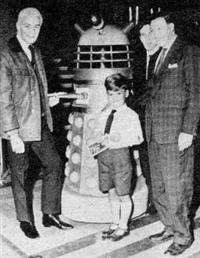
Bill Roberts retired and sold the Shawcraft companies in July, 1987 to David Harrington of L & R Engineering; the name continued at Rockingham Road until it was wound-up early in the 21st Century. Bill Roberts had moved from his Southall terraced home in 1956 to Swallowfielde, a detached house in Swallow Street, Iver Heath in the grounds of which he designed and built a large detached bungalow where he died aged 73 in 1992; his wife Anne died some five earlier. They had a daughter, Annette and two sons; young Bill developed a specialist classic car restoration business in the Thames Valley and David, the younger son, ran a precision engineering business in South Wales.
Vic Bowden (1929-) the foreman, lived in Pinewood Green, Iver Heath and retired from Shawcraft on 4th July 1994.